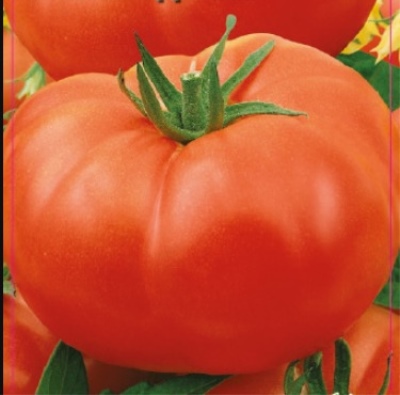
- Authors: Guseva L. I., Nikulaesh M. D. (Agrofirma Aelita LLC, Transnistrian Research Institute of Agriculture)
- Year of approval: 1999
- Category: grade
- Growth type: indeterminate
- Appointment: fresh consumption, for juice
- Ripening period: mid-season
- Ripening time, days: 111-115
- Growing conditions: for open ground, for film greenhouses
- Bush height, cm: 120
- Bush characteristic: powerful
International cooperation sometimes brings very good results, and this is also fully manifested in the field of breeding. Tomato Heavenly Delight, which became one of the results of such cooperation, deserves the closest study.
Breeding history
The leading breeders in this project were L.I. Guseva and M.D. Nikulaesh. They represented, respectively, the agrarian company "Aelita" and the Transnistrian Research Institute of Agriculture. In Russia, the variety was approved for official use in 1999.
Description of the variety
Paradise pleasure is characterized by an indeterminate development. You can plant such a culture safely even in a greenhouse, even in an open garden. The bushes are distinguished by strong growth. They are able to rise up to 1.2 m. Large green foliage is formed on the shoots.
The main qualities of the fruit
The earliest berries of Paradise Delight are distinguished by their green color. A dark green spot is always present in the area of the stalk. When the fruits of this variety ripen, they invariably turn red. The rest of the properties are as follows:
- usual weight 0.35-0.4 kg;
- simple circle shape;
- weak ribs;
- development from simple inflorescences;
- articulated stalk type.
Taste characteristics
Almost all tasters like the juiciness of the pulp of such a culture. The meatiness is also, undoubtedly, a positive point. Taste reviews are generally favorable. The sugar content in fruits is quite high. The crop is used fresh, and can also be processed into juice.
Ripening and fruiting
Tomato Paradise Delight is positioned as a mid-season variety. Under normal conditions, it ripens in 111-115 days. True, this schedule can be invaded by various factors, including bad weather. Most of the harvest is obtained in July and August.
Yield
On 1 bush of such a tomato, 3-4 kg of berries can be grown. The total number of fruits per 1 m2 reaches 7 kg. But this result is obtained, of course, not automatically, but thanks to the efforts of farmers and only with scrupulous adherence to the necessary agricultural technology.
The timing of planting seedlings and planting in the ground
Sowing seeds in seed containers or simple boxes should be during March. Ready for shipment under film is usually achieved by mid-May. In the first decade of summer, plants can also be transplanted into open ground. But important conditions must be met - age 60-65 days, as well as sufficient vegetative development.

Growing tomato seedlings is an extremely important process, because it largely depends on whether the gardener will be able to harvest at all. All aspects must be taken into account, from seedbed preparation to planting in the ground.
Landing scheme
The most consistent with the instructions of the supplier of planting material is the 500x600 mm system. For 1 sq. m, no more than 3 bushes are allowed. Too thick a variant already predictably creates more problems than benefits.

Growing and care
When planting seedlings, it is strongly recommended to ensure that the earthen lump surrounding the roots remains intact. When preparing holes, stakes or trellises should be prepared in advance. For cultivation, soil with a neutral level of acidity is optimal. Like other tomatoes, according to the rules of crop rotation, Paradise Delight cannot be planted where other nightshade crops used to grow. After planting and watering, the holes are sprinkled with compost on top to better retain moisture.
Top dressing is carried out at least 4 times during the season. Organics are alternated with minerals to maximize the needs of the plant. The bushes are formed into 1 trunk (according to the instructions of the seed supplier). In unofficial publications indicate that they can be carried in 2 stems, but gardeners are making such an attempt at their own responsibility. When the bushes are watered, the ground around them must be loosened.




A plant needs different micronutrients at each stage of growth. All fertilizers can be divided into two groups: mineral and organic. Folk remedies are often used: iodine, yeast, bird droppings, eggshells.
It is important to observe the rate and period of feeding. This also applies to folk remedies and organic fertilizers.
Disease and pest resistance
Declared resistance to:
- bacterial spotting;
- cladosporium disease;
- tobacco mosaic.
However, this does not negate the need to help the plant and treat it prophylactically.


Growing regions
It is equally possible to get a decent harvest of tomatoes Paradise Delight in:
- Western Siberia;
- environs of Moscow and St. Petersburg;
- middle lane;
- the Volga basin;
- territories and republics of the North Caucasus;
- Central Black Earth Region.

























































































